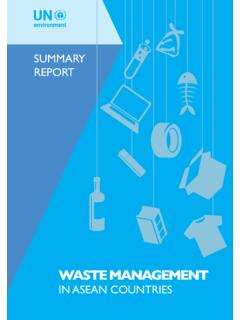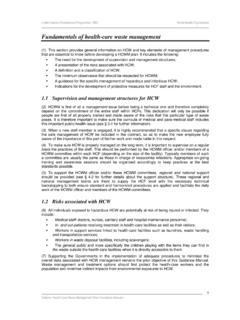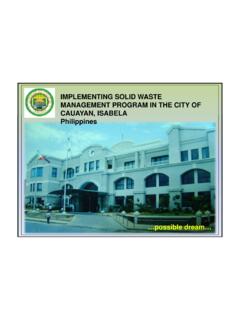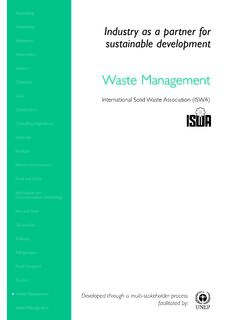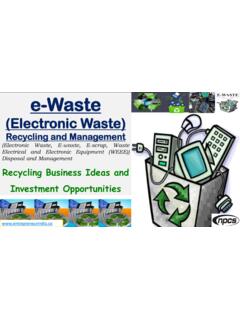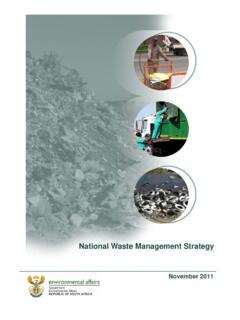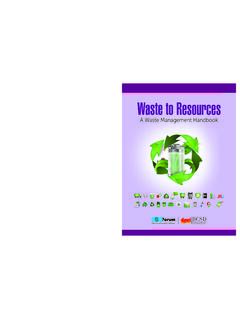Transcription of Study Paper On e-waste management
1 0 Study Paper On e-waste management By Ram Krishna, DDG(FA), TEC , New Delhi & , Director (ER), RTEC, Kolkata 1 Table of Contents Para No. Contents Page No Introduction 3 An estimation to e-waste 4 Effects of e-waste on human health and environment 4 management of e-waste 6 ITU- Technical guidelines 6 ITU- Present Activities 8 Problems in the implementation of a strategy on ICT- waste 9 Indian scenario for e-waste management 9 Existing Regulations 10 TRAI guidelines 13 DoT s action towards greening the environment 14 Works of the Research unit of Rajya Sabha Secretariat 15 Stakeholders 15 EPR and few good practices in India 16
2 Concerns/ Challenges for e-waste management 17 Towards Sustainability 18 Conclusion 19 Recommendations 21 References 22 Abbreviations 23 2 e-waste management Abstract: In an approach to bridge the digital divide, it is necessary to get an affordable, equitable and quality access to ICT. It is estimated that two third of world s population is still offline so there is a need to provide affordable access to internet for all. For developing countries, it has become a priority area to alleviate poverty by promoting access to ICT.
3 At the same time, tremendous growth in use of ICT devices and services, faster change of technology and frequent innovations in ICT sector, had left the world with a threat of deterioration in environmental conditions and human health as the- waste of electronic and electrical equipment, which contains hazardous components, is still handled in an environmentally unfriendly manner mainly in developing nations. It is huge challenge for the nations to handle e-waste in responsible manner and protect the environment.
4 In this Paper an approach is made towards assessing the present situation of e-waste management globally as well as in India, considering the present regulations and guidelines. It is also a fact that major part of recycling of e-waste is being handled by informal sector who have little/no knowledge about the consequences of exposure to hazardous substances. To address the issue of e-waste management in a sustainable method, the concept of EPR (extended producer responsibility) will be helpful if the regulations incorporate monitoring and penalty clauses.
5 The reuse of EEE has greater environmental and social benefits than recycling as it increases the useful life time of the ICT equipment and enables greater resource efficiency and energy efficiency. In developing nations, it can help in uplifting the status of the informal sector with help of education and employment. In addition to the technical, social and organizational aspects of the EEE- waste management system, it is also crucial to consider the economic aspects, if the system has to be made financially viable and sustainable along with being socially acceptable.
6 3 Introduction: It is a hard fact that with the voluminous increase in use of ICT devices to bridge the digital divide, there is also an alarming growth of e-waste world wide. e-waste is defined as waste electrical and electronic equipment, whole or in part or rejects from their manufacturing and repair process, which are intended to be discarded whereas electrical and electronic equipment has been defined as equipment which is dependent on electrical currents or electro-magnetic fields to be fully functional.
7 There is a need for e-waste management as e-waste components may cause severe health risks and environmental damage, when crude, unscientific methods are applied for recovery of useful components. There is a need to encourage recycling of all useful and valuable material from e-wastes to preserve the natural resources. Most of the developing countries are suffering with the rapidly growing problems of e-waste and have to have sound e-waste management systems for end of life ICT products to avoid the threat on environment and mankind.
8 The rapid growth of ICT, frequent innovations and technological changes are resulting in shorter life span of ICT equipment. Moreover in developing countries the quantity of imported disused Electrical and Electronic equipment (EEE) is uncontrolled .So the volume of e-waste has also increased drastically in developing and developed nations. At the same time, it is encouraging that every nation, along with going for the development in the ICT sector, is also working for going green by taking care of issues like efficient use of natural resources, minimization of e-waste , sustainable recycling of e-waste and development of products with minimum use of hazardous substances.
9 Electrical and electronic equipment (EEE) contain valuable as well as hazardous materials and if at end of life of EEE, the hazardous materials are not disposed of scientifically it may cause serious damage to the environment and public health. The presence of heavy metals (like Arsenic, Cadmium, Barium, Lead, Lithium, Mercury, Nickel, Zinc Sulphide) and other toxic substances like PCB (Polychlorinated biphenyls) etc. may cause extreme harm, if not disposed of in environment friendly manner. ITU has accepted the fact that the regulations in many developing countries to cover the areas of WEEE ( waste Electrical and Electronic Equipment)areinadequateas they exclude key topics and key stake holders like the informal sector.
10 The collection, recycling, recovery and associated activities of e-waste management by the informal sector having little/no knowledge about techniques, precautions etc, cause more damage to their health and environment. So goingin line withthe definition of environmental sustainability the ability to maintain the qualities that are valued in the physical environment by the use of design for environment principles, efficient use of non -renewable resources, efficient and environmentally sound recycling and use of renewable resources as much as possible , in order to have a sustainable policy to handle e-waste in an environment friendly manner.
